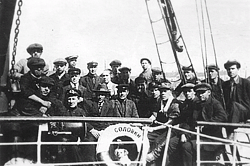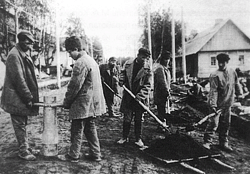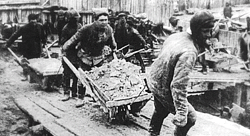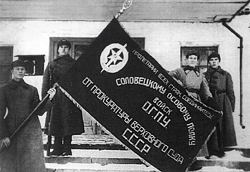Volume 2. Solovki GULAG
Solovetsky Camp
"The Solovetsky Islands (Russian: Соловецкие острова), or Solovki (Соловки), are an archipelago located in the Onega Bay of the White Sea, Russia. Area: 347 square kilometers (134 sq mi). "
( The Solovki Encyclopedia )
"Today in Solovki, tomorrow all over Russia!" (The Camp slogan)
Solovetsky Camp and GULAG
Prison in Russia is more than just a prison. Russian prisons have reached the unimaginable level of humiliation of the human personality. This special spirit of Russian prisons was formed over centuries. The Solovetsky monastery, up to the XIX century, was the only official prison of the Russian state, influenced greatly the process of organization of Russian prisons.
 People were exiled to Solovki for treason, theft, blasphemy and endangering life by order of Metropolitan or Sovereign. Heretics, vagabonds, sectarian, rebels, objectionable high officials, state criminals, monks-drunkards were exiled to Solovki. It so happened that having absorbed a prison, the monastery became a prison. Holiness had not overpowered the prison spirit. Monks had become jailers. First prisoners appeared already in the wooden monastery. The monk Sylvan was under arrest here because of his protests against church usury, monastery possessions and speculation. When stone buildings appeared, special places for prisoners were constructed. Research done by V. Burov shows: that the project of the fortress served not only a defense function but also that of a prison. For example, the runaway Arsenii Greek was imprisoned in a cell of silence. Proto-priest Sylvester, the author of very widely read religious book Domostroy and influential high official at the court of Ivan the Terrible had become the third prisoner of the Solovetsky monastery. A great number of historically significant personalities were punished on Solovki. Former Russian Tsar Simeon Bekbulatovich; a participant of the defense of Troitsky monastery Avraamii Palitsyn; Prince Lvov and archimandrite Nikanor (the enemies of Patriarch Nikon); diplomat and Senator Peter Tolstoy with his son were under arrest in the monastery at different times. These people were imprisoned in different conditions, which depended on instructions. For example, one silver ruble a day was given to maintain the chieftain Kalnishevsky. But the clothing of Vasilii Dolgoruky (in the time of Peter I) had rotted away over a year. Researcher M. Kolchin wrote: "...not only did Solovki monk Trifon work diligently in order to build the inside walls into such casemates that no prisoner could escape, but also that God's light could hardly enter into these coffins for living people".
People were exiled to Solovki for treason, theft, blasphemy and endangering life by order of Metropolitan or Sovereign. Heretics, vagabonds, sectarian, rebels, objectionable high officials, state criminals, monks-drunkards were exiled to Solovki. It so happened that having absorbed a prison, the monastery became a prison. Holiness had not overpowered the prison spirit. Monks had become jailers. First prisoners appeared already in the wooden monastery. The monk Sylvan was under arrest here because of his protests against church usury, monastery possessions and speculation. When stone buildings appeared, special places for prisoners were constructed. Research done by V. Burov shows: that the project of the fortress served not only a defense function but also that of a prison. For example, the runaway Arsenii Greek was imprisoned in a cell of silence. Proto-priest Sylvester, the author of very widely read religious book Domostroy and influential high official at the court of Ivan the Terrible had become the third prisoner of the Solovetsky monastery. A great number of historically significant personalities were punished on Solovki. Former Russian Tsar Simeon Bekbulatovich; a participant of the defense of Troitsky monastery Avraamii Palitsyn; Prince Lvov and archimandrite Nikanor (the enemies of Patriarch Nikon); diplomat and Senator Peter Tolstoy with his son were under arrest in the monastery at different times. These people were imprisoned in different conditions, which depended on instructions. For example, one silver ruble a day was given to maintain the chieftain Kalnishevsky. But the clothing of Vasilii Dolgoruky (in the time of Peter I) had rotted away over a year. Researcher M. Kolchin wrote: "...not only did Solovki monk Trifon work diligently in order to build the inside walls into such casemates that no prisoner could escape, but also that God's light could hardly enter into these coffins for living people".
 More than 400 persons were exiled to the monastery prison during the times of Ivan the Terrible. Solovki archimandrite Illarii wrote: "the name Solovki became terrible in the history of Russia". In 1798 near the Korozhnaya tower a special prison yard was organized. The icon-painting chamber was converted into the prison with 28 cells. In 1903 Solovki prison ceases to exist.
More than 400 persons were exiled to the monastery prison during the times of Ivan the Terrible. Solovki archimandrite Illarii wrote: "the name Solovki became terrible in the history of Russia". In 1798 near the Korozhnaya tower a special prison yard was organized. The icon-painting chamber was converted into the prison with 28 cells. In 1903 Solovki prison ceases to exist.
Prisoner Abel (foreteller) wrote "ten times I was under the threat of death, one hundred times fell into desperation".
Prisoner Pakhomov (provincial secretary) begged to be transferred "from the icy-cold, far away, dark, unsociable island where not only does human health, but also iron grow rusty".
It took only 17 years for the prison to rise from the past. The first concentration camp for the prisoners of Civil War was organized on the islands. In 1923 the Solovetsky camp of Special Destination, known as SLON was opened. In the same year the first mass military execution of prisoners took place. More than 1 million people were prisoners of Solovetsky camp and of its other departments on the continent (the territory from Petersburg to Norilsk). In 1937, before the formation of the Solovetsky prison of Special Destination, 2000 prisoners were killed. No one will be able to understand horror and desperation of former Solovki prisoners. And no one will be able to describe those prisons better than they could.
 Prisoner M. Nesterov: "Hell building".
Prisoner M. Nesterov: "Hell building".
Prisoner O. Yafa: "Suffering is the uniting sign, so called a national» sign here".
Prisoner O. Volkov: " ….in front of our eyes they beat up people, force them to run from one place to the other, searched them all over, frightening them with rifles firing blank shots aimed from the towers. The fallen ones were raised and guards kicked them in the face with their feet into a blood mess".
Prisoner I.Zaytsev: "... prisoners using their own body heat were warming their cells, so during cold weather a thick fog was every where; droplets of breath were froze on the walls and ceilings; the air was thick and suffocating".
The newspaper Izvestiya dated September, 21, 1929: "Nothing remained in Solovetsky camp from the regime, that used the rock cells...".
 Prisoner B.Sederkholm: "prisoners enter into the water up to the throat during September, the end of autumn on Solovki and push slippery logs to the coast by hand. It is real torture, to drag this slippery wet log, to stumble grasp bushes. Only death can free you from the work"
Prisoner B.Sederkholm: "prisoners enter into the water up to the throat during September, the end of autumn on Solovki and push slippery logs to the coast by hand. It is real torture, to drag this slippery wet log, to stumble grasp bushes. Only death can free you from the work"
Prisoner E. Solovyev: "... prisoners were forced to eat excrement: on shoulders of officers they cut out the skin. Those who called the name of God were crucified naked...".
The report of the Polish secret police USLAG. 1928 - 1932: "Relations of the guards to the prisoners is very strict and borders on sadism. Characteristic punishments: slaughter by sticks, showers in the frost, swimming in ice-holes and standing in the frost for several hours...".
Prisoner A. Pishchalnikov: "they forced us to roll large boulders from one place to the other. Our tools were only our hands".
Prisoner V.Dvorzhetsky: "naked, dead, frozen people everywhere-all around the most objectionable poses; elbows, hands, legs, heads, backs sticking out the snow".
Prisoner V. Chekhovsky: "It is impossible to conceal the killings of prisoners".
Prisoner Y. Danzas: "...and each morning people, armed with long sea hooks, through slightly opened gates, hook the dead bodies in order to take out the corpses. At the same time live prisoners attempted to hold on to the dead bodies, to serve them instead of mattresse".
Writer M. Gorky: "It seems to me, that the conclusion is clear: such camps as Solovki are necessary... Specifically, by this method the state will reach one of its purposes: the destruction of prisons".
The state has heeded the conclusions of the writer: such camps appeared in Russia. In 1939, when Solovki prison was closed, the satanic horrors of the Solovki experience had already extended all over the country. Even today Russia maintains the memories of that epoch. The GULAG has perfectly penetrated the structure of the country, deep into the souls of each of its citizens...
Prof. Florensky was executed on Solovki
 Pavel Florensky was then professor of mathematics and physics at the university of Moscow. He was eventually sent to a Solovki concentration camp by the communist regime and executed in 1937.
Pavel Florensky was then professor of mathematics and physics at the university of Moscow. He was eventually sent to a Solovki concentration camp by the communist regime and executed in 1937.
"In November of 1934 Pavel Florensky "...was moved to Solovki where at first he was given an opportunity to study iodine and seaweeds (Florensky's discoveries are valued to this day). Then the conditions were toughened, there was no longer economic necessity to maintain the iodine station, and the SLON (Solovetsk Special Purpose Camp) was slowly moving to a closure. At the end of 1937, the inmates were moved en masse to Leningrad where after a formal re-trial they were shot, usually within a fortnight. Father Pavel's Judgement Day came on December 8." (Alexei Mokrousov. Pavel Florensky Russia's Da Vinci. New Times, the digest of Novoe Vremya. Moscow. September 2006)
Поделиться в социальных сетях